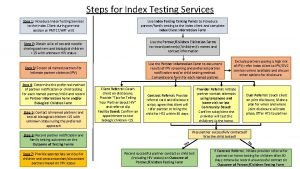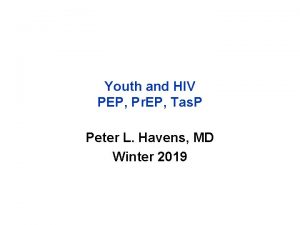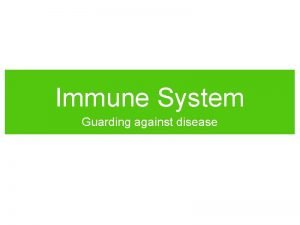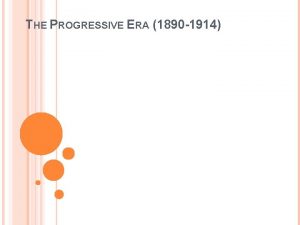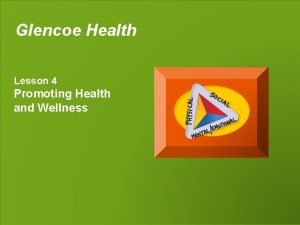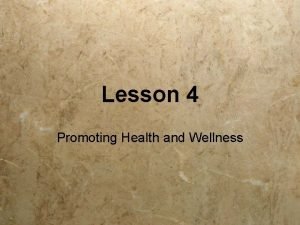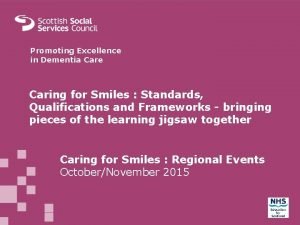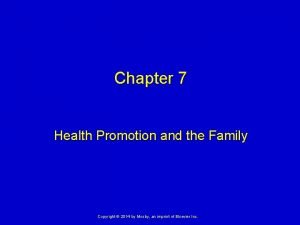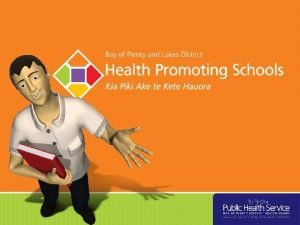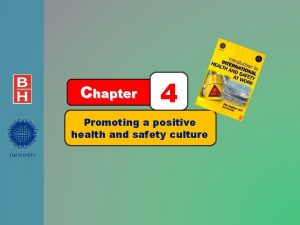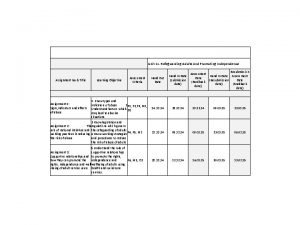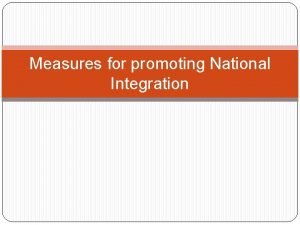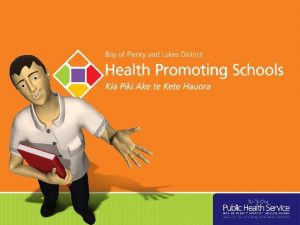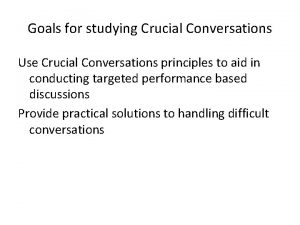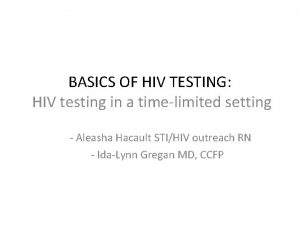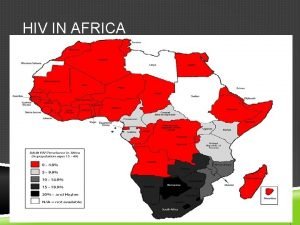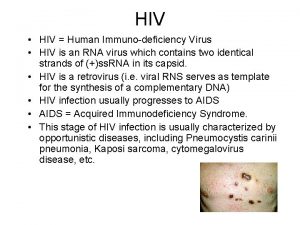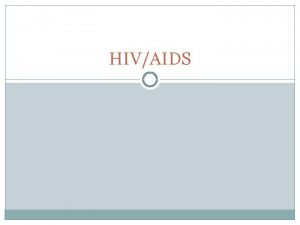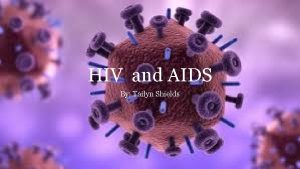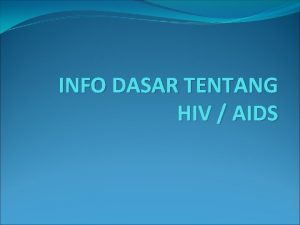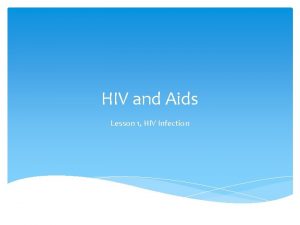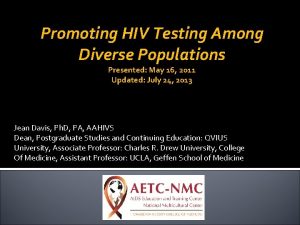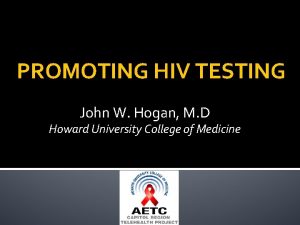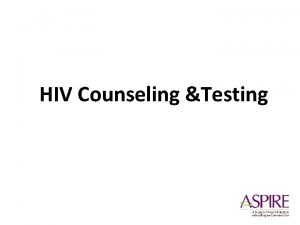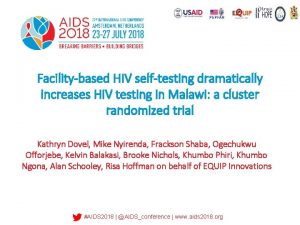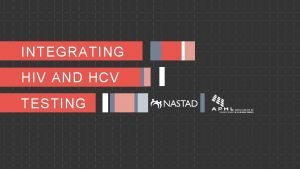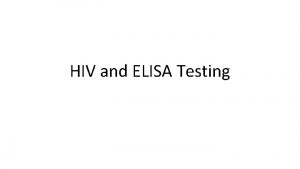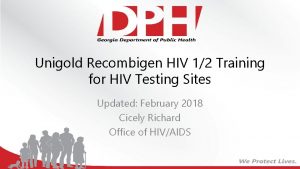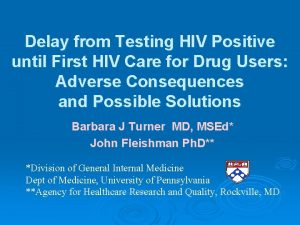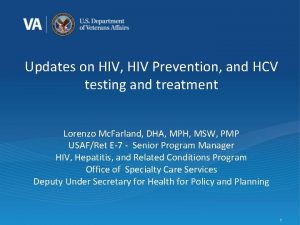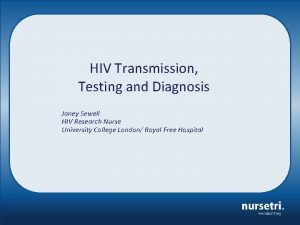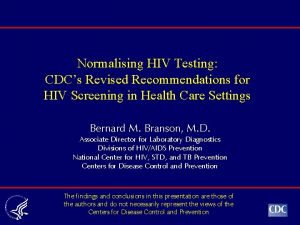PROMOTING HIV TESTING WHY HIV TESTING IS CRUCIAL




























- Slides: 28

PROMOTING HIV TESTING WHY HIV TESTING IS CRUCIAL I. Jean Davis, Ph. D, PA, AAHIVS Manager - Clinical Services Desert AIDS Project

Objectives Upon completion of this session the participants should be able to: Understand the connection between the HIV rates in the District of Columbia and the need for increased HIV testing. Identify the CDC recommendations for screening pregnant women for HIV infection. Describe strategies for counseling patients who refuse HIV testing.

Chronic HIV in the US Chronic HIV is underdiagnosed and undertreated Prevalence of HIV in the US ▪ 1. 1 – 1. 2 million living with HIV infection 80% Diagnosed 40% Treated 20% Viral Suppression (HIV RNA <50)

HIV in the District of Columbia As of December 2010, an estimated 14, 465 D. C. residents, or 2. 7% of adults/adolescents, were living with HIV. The HIV prevalence exceeds 1% for all racial/ethnic groups (for which data are provided). Fact Sheet-The HIV/AIDS Epidemic in Washington, D. C. The Henry J. Kaiser Family Foundation

HIV in the District of Columbia 4. 3% of Black adult/adolescent residents are living with HIV, compared to: 1. 8% of Latino residents and 1. 2% of White residents HIV prevalence is highest among Black men – 6. 3% of Black men are living with HIV, followed by: Latino men (3. 0%) Black women (2. 6%) Fact Sheet-The HIV/AIDS Epidemic in Washington, D. C. The Henry J. Kaiser Family Foundation

HIV in the District of Columbia Women: HIV prevalence is highest among Black women (2. 6%). Higher than in White men (2. 4%) Black women represented a third (34%) of Blacks living with HIV in 2010. Latinas represented 16% of Latinos living with HIV in 2010. White women represented 4% of Whites living with HIV in 2010. Fact Sheet-The HIV/AIDS Epidemic in Washington, D. C. The Henry J. Kaiser Family Foundation

HIV in the District of Columbia Testing: 68% of D. C. residents (ages 18– 64) report never having been tested for HIV, the highest share of any state. Over the last several years, fewer people have been diagnosed with HIV late in their illness (those who have been diagnosed with AIDS within one year of testing positive for HIV for the first time). Among those who were diagnosed with HIV in 2009, 1/3 progressed to AIDS within a year of HIV diagnosis. Fact Sheet-The HIV/AIDS Epidemic in Washington, D. C. The Henry J. Kaiser Family Foundation

HIV in the District of Columbia Linkage to Care: The large majority of people newly diagnosed with HIV in 2010 (89%) were linked to care within 12 months of their initial diagnosis. 76% were linked to care within three months of their diagnosis. Fact Sheet-The HIV/AIDS Epidemic in Washington, D. C. The Henry J. Kaiser Family Foundation

HIV Testing The CDC Recommendations

Adults and Adolescents: Recommendations for HIV-Screening Location All primary care settings Emergency departments, in-patient services, and urgent care clinics Public health settings Tuberculosis clinics Sexually transmitted diseases clinics Substance abuse treatment centers Correctional facility treatment centers Branson BM, et al. MMWR Recomm Rep. 2006; 55(RR-14): 1 -17

Revised CDC Recommendations for HIV Testing in Healthcare Settings CDC's recommendations urge providers to include HIV testing as a routine part of their patients’ healthcare. Routine HIV testing ensures more people learn whether they are infected with HIV, allowing them to benefit from earlier access to treatment and reduce the risk of infecting their partners. http: //www. cdc. gov/hiv/topics/testing/healthcare/

CDC Revised HIV Screening: Recommendations for Pregnant Women Universal opt-out screening Included in routine panel of prenatal screening tests Notification and option to decline Second test in third trimester for women who are: Known to be at risk for HIV In communities with elevated HIV incidence In high-prevalence health care facilities Labor and delivery opt-out rapid testing for women with undocumented HIV status Initiate antiretroviral prophylaxis on basis of test result Rapid testing of newborn if mother’s status unknown at delivery Initiate antiretroviral prophylaxis within 12 hours of birth on basis of rapid test result Branson BM, et al. MMWR Recomm Rep. 2006; 55(RR 14): 1 -17

Make HIV Testing Easy In June 2006, DC launched - Come Together Get Screened for HIV. This campaign promoted testing among residents 14 -84 Incorporate HIV test into general women’s lab form/ health panel: pap smear, mammogram, GC/Chlamydia screen/cholesterol Incorporate HIV test into routine tests for cholesterol, glucose, CBC, PSA Pair HIV tests with all other STD tests – no RPR, GC or chlamydia test should be ordered WITHOUT an HIV test

HIV Test Results Negative Indeterminate Positive

HIV Test Results - Negative HIV testing might present an ideal opportunity to provide or arrange for prevention counseling to assist with behavior changes that can reduce risks for acquiring HIV infection. Prevention counseling should be offered or made available through referral in all health-care facilities serving patients at high risk for HIV and at facilities (e. g. , STD clinics) in which information on HIV risk behaviors is elicited routinely. Health-care providers should subsequently test all persons likely to be at high risk for HIV at least annually.

HIV Test Results - Indeterminate Studies had established correlation of an indeterminate HIV test results with: Pregnancy Hemodialysis Systemic lupus Malignancies erythematosus Rheumatoid factor Leprosy Post-measles virus infection Elevated bilirubin Urologic disorders Sexually transmitted diseases Multiple blood transfusions

HIV Test Results - Indeterminate An indeterminate HIV test result can be treated as negative if it is not accompanied by positive detection using a molecular test, in particular, an RNA test with primer sets covering HIV-1/2/O. HIV 1 RNA HIV 2 RNA “Frequency, Causes, and New Challenges of Indeterminate Results in Western Blot Confirmatory Testing for Antibodies to Human Immunodeficiency Virus” M Guan; Clin Vaccine Immunol. 2007 June; 14(6): 649– 659.

HIV Test Results - Positive All positive rapid test results are preliminary. Confirmatory serum HIV ELISA/Western Blot testing is performed on all positive rapid test results. The HIV test result is not given as positive without a confirmatory positive serum Western Blot.

HIV Testing Addressing Those Who Refuse

HIV Test Refusal There are some crucial points about the opt-out approach: The patient can refuse the test — they can opt-out. Second, if the HIV test result is positive, the patient will be given post-test counseling. Third, patients who opted-out (refused) will be provided with a longer session of counseling, which starts by letting them express their concerns and reasons for objection to the test, so you can address their specific questions and worries. Lab. Space-16. 6. 2 Counseling women who refuse HIV testing

HIV Test Refusal In order to counsel opted-out patients effectively you need to build trust. Emphasize that getting an early diagnosis and starting treatment or prophylaxis greatly improves the chances of survival for patients who are living with HIV. Knowing one’s HIV status has better outcomes of follow -up and treatment. Disclosing the truth to their family has a big advantage because they can support them. Lab. Space-16. 6. 2 Counseling women who refuse HIV testing

HIV Test Refusal If a patient continues to refuse the HIV test, further counseling should be provided in subsequent care visits. They should be reassured that opting-out of HIV testing will not affect their access to care related services. Encourage them to reconsider testing.

Summary The DC HIV rate is above epidemic level for all reporting ethnicities. All pregnant women should be screened during their initial prenatal testing and again in the third trimester. An indeterminate HIV test is negative if follow up HIV 1 RNA and HIV 2 RNA test are both negative.

Case Study Discussion

Clinical Case Study #1 25 year old man told by his PCP that he is HIV+ Comes to Howard University Hospital for second opinion on treatment Brings parents, brother and sister to clinic Girlfriend flown in from Manilia Everyone in tears HIV Elisa +, Western blot negative, HIV PCR negative PCP can be sued for not waiting for the confirmatory Western blot results?

Clinical Case Study #2 35 year old woman comes in for evaluation of low back pain. She has been divorced for 5 yrs after 12 years of marriage and is not currently dating or sexually active since the divorce. Afraid of her HIV test result, she refuses testing. Her brother died of AIDS 12 years ago. How do you counsel her after her refusal to get tested?

Resources www. aetcnmc. org www. capitolregiontelehealth. org

Howard University HURB 1 1840 7 th Street NW, 2 nd Floor Washington, DC 20001 202 -865 -8146 (Office) 202 -667 -1382 (Fax) www. capitolregiontelehealth. org www. aetcnmc. org
 Pictures
Pictures Section 3 communicating with graphs answer key
Section 3 communicating with graphs answer key 10 steps of index testing
10 steps of index testing Cdc hiv testing
Cdc hiv testing Why do the bodys antibodies fail to protect people from hiv
Why do the bodys antibodies fail to protect people from hiv Dont ask
Dont ask Promoting moral improvement
Promoting moral improvement Promoting services and educating customers
Promoting services and educating customers Promoting alternative thinking strategies
Promoting alternative thinking strategies Lesson 4 promoting health and wellness
Lesson 4 promoting health and wellness Promoting family earthquake preparedness
Promoting family earthquake preparedness Chapter 1 understanding health and wellness lesson 4
Chapter 1 understanding health and wellness lesson 4 Promoting racial literacy in schools
Promoting racial literacy in schools Lesson 4 promoting health and wellness
Lesson 4 promoting health and wellness Philip curry business
Philip curry business Keeping an infant safe and well section 7-3
Keeping an infant safe and well section 7-3 Promoting excellence in dementia care
Promoting excellence in dementia care What is deontological ethics
What is deontological ethics Chapter 7 promoting health and wellness
Chapter 7 promoting health and wellness Chapter 30 promoting bowel elimination
Chapter 30 promoting bowel elimination Chapter 13 distributing and promoting products
Chapter 13 distributing and promoting products Promoting services and educating customers
Promoting services and educating customers Health promoting schools model
Health promoting schools model Rehearsal strategies
Rehearsal strategies Promoting a positive health and safety culture
Promoting a positive health and safety culture Unit 11 safeguarding adults and promoting independence
Unit 11 safeguarding adults and promoting independence Principles of international understanding
Principles of international understanding Institutions supporting entrepreneurship
Institutions supporting entrepreneurship Health promoting school
Health promoting school


